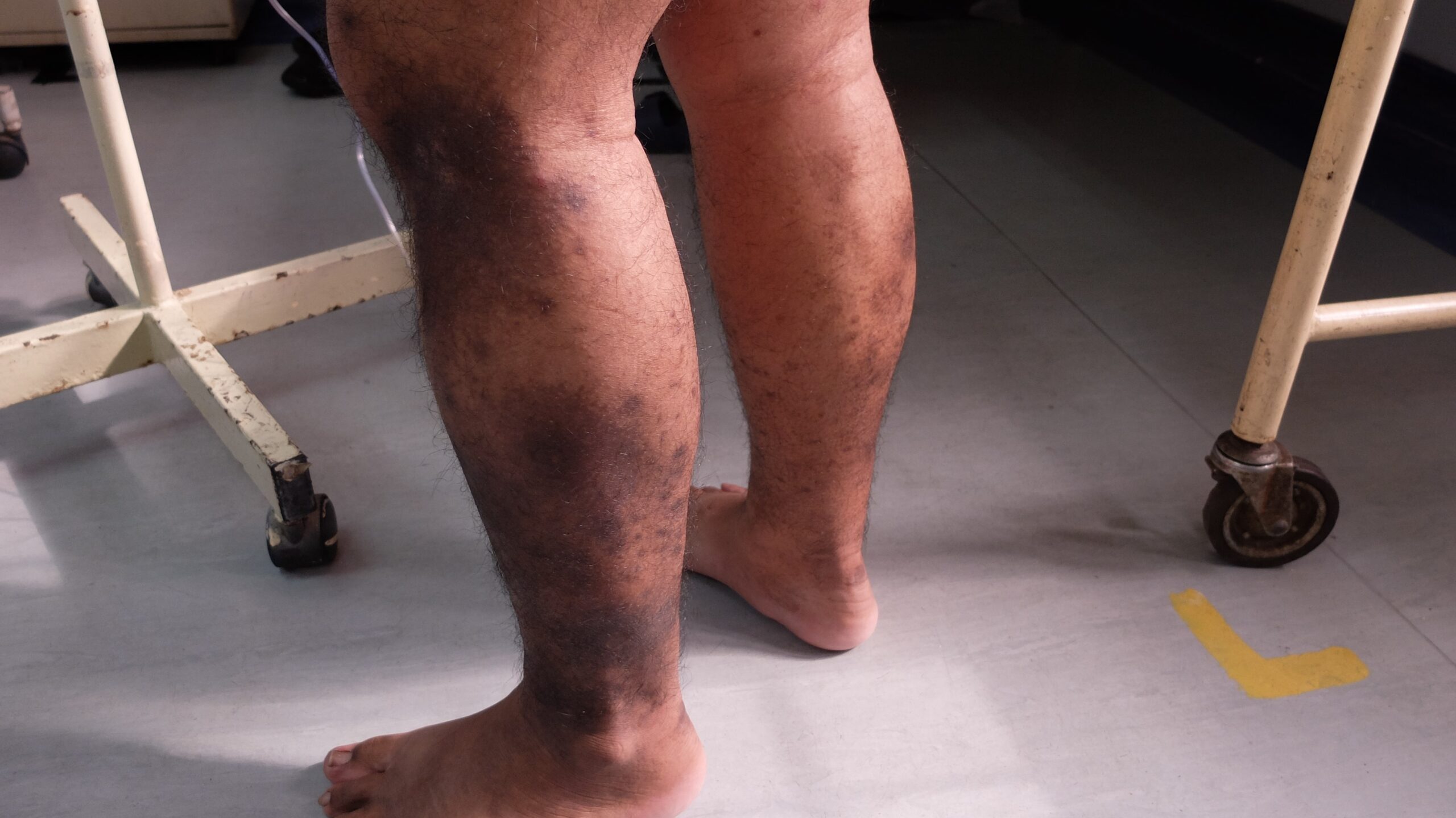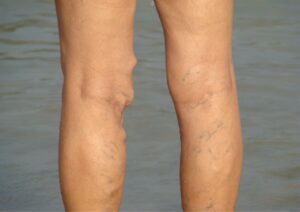Table of Contents
Venous stasis or venous dermatitis, also known as being a part of chronic venous insufficiency, are Health conditions characterised by having trouble sending blood from blood vessels in the legs back to the heart.
It is caused by damage or dysfunction in the valves of the leg veins, causing blood leaks and blood pooling.
Those valves on the leg veins are responsible for ensuring that blood flows in the correct direction. In healthy veins, the valves open to allow blood to flow towards the heart and close to prevent backflow.
When the valves of the affected vein are damaged, blood can flow backwards and pool in the damaged vein, leading to a range of symptoms and complications.
From their medical history, patients presenting spontaneous damage of the leg veins, have often a family history of chronic venous insufficiency.
Venous dermatitis is a common condition of chronic venous insufficiency, affecting millions of people worldwide. It can occur in people of all ages, although it is more common in older adults. There are several risk factors associated with those skin changes, including obesity, pregnancy, prolonged sitting or standing, and a family history of blood clots or varicose veins.
The stages of chronic venous insufficiency, are closely related to venous dermatitis.
Chronic venous disease is a progressive condition that develops over time and is characterised by a range of symptoms, including leg swelling, pain, and varicose veins. There are several stages of chronic venous insufficiency, each with its own set of symptoms and complications.
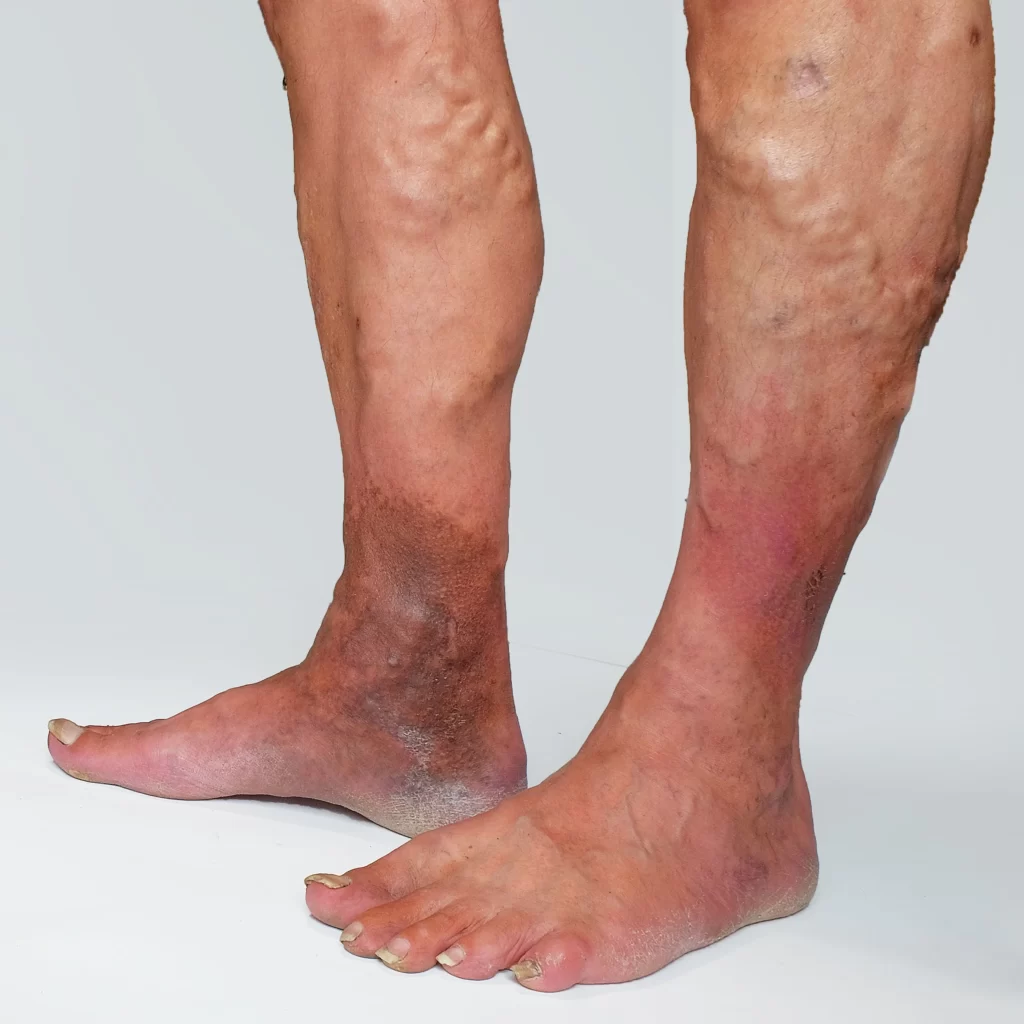
What does venous stasis look like?
Venous stasis, also known as venous insufficiency, can cause a variety of skin changes and symptoms in the affected areas. The appearance of venous dermatitis can vary depending on the severity of the chronic venous insufficiency and duration of the condition.
In the early stages of venous dermatitis, the skin’s tissue may appear reddened, swollen, and itchy. This may be accompanied by a feeling of heaviness or achiness in the leg affected by chronic venous insufficiency .
As the condition progresses, the skin may become discoloured and thickened, with a bumpy or scaly texture. It may also appear shiny or tight, with a yellowish or brownish tint.
In more advanced cases, the skin may develop open sores or ulcers. These are typically located on the lower leg or ankle, and can be painful and difficult to treat. The tissue around the ulcer may be reddened, swollen, or discoloured, and there may be a foul-smelling discharge.
Venous dermatitis can also cause changes in the leg veins themselves and surrounding tissue. The veins may appear bulging or twisted, with a bluish or purplish colour. This is due to the blood pools in deep veins in the affected area, which can lead to varicose veins or spider veins.
Other symptoms of venous dermatitis can include leg cramps, restless legs, and a feeling of tightness or pressure in the affected leg. In severe cases, the leg may feel cold or numb, and there may be a loss of sensation or muscle function.
How Can Venous Stasis lead to Venous Ulcers?
Venous stasis can lead to the development of ulcers , particularly in the lower limb or ankle area. This occurs because the increased pressure within the blood vessels and swelling of healthy vein caused by venous insufficiency can damage the skin’s tissue, leading to a breakdown in the skin’s integrity and the formation of an open wound.
When blood flow in the veins is impaired, it can lead to a build-up of fluid in the affected area, which can lead to further skin’s damage and cause inflammation.
Over time, the skin may become discoloured, thickened, and hardened, with a bumpy or scaly texture. This condition, known as lipodermatosclerosis, can make the skin more susceptible to injury and infection.
Venous stasis Ulcers can develop when the skin is repeatedly damaged and unable to heal properly. The most common type of venous ulcer associated with venous dermatitis is called a venous ulcer. It is a more advanced complication of chronic venous insufficiency.
These ulcers typically appear on the lower leg, near the ankle, and are characterised by a shallow, crater-like appearance. They may be painful and produce a foul-smelling discharge.
Venous stasis ulcers can be difficult to treat, as they often recur and may take months or even years to heal completely.
Treatment typically involves addressing the underlying cause of venous insufficiency, such as:
compression therapy with compression stockings to reduce swelling
lifestyle changes to improve blood flow
topical or oral medications to promote healing and prevent infection
In some cases, surgery may be necessary to repair the damaged vein.
What Causes Venous Stasis Dermatitis?
Venous dermatitis is caused by chronic venous insufficiency, which is a condition in which the veins in the legs are unable to efficiently return blood to the heart. This can lead to a build-up of blood and fluid in superficial veins in the lower legs, which can cause swelling and inflammation in the skin’s tissues.
Venous insufficiency can occur for a number of reasons, including damage to the valves in the leg veins, which normally help to prevent blood from flowing backward. When these valves become weak or damaged, blood can flow back down into the legs and feet, leading to increased pressure, fluid buildup and chronic venous insufficiency.
Chronic venous insufficiency is diagnosed through a thorough medical history, a physical exam, assessment of other risk factors and a duplex ultrasound.
Duplex ultrasound imaging uses sound waves to assess the large veins, smaller varicose veins and other veins of the leg. Those imaging tests are helpful to assess the severity of the circulation problems and design a treatment plan
Other factors that can contribute to venous insufficiency and venous dermatitis include:
Aging:
As we age, our veins may become less elastic and less able to contract effectively, which can impede blood flow.
Pregnancy:
The increased weight and pressure of the growing uterus can put extra strain on the veins in the legs, leading to venous insufficiency.
Obesity:
Being overweight or obese can increase the risk of developing venous insufficiency by putting extra pressure on the veins.
Inactivity:
Long periods of sitting or standing can impair blood flow in the legs, leading to venous insufficiency.
Prior deep vein thrombosis (DVT):
A history of DVT can damage the veins and valves, increasing the risk of venous insufficiency.
When the skin becomes inflamed and damaged due to venous dermatitis, it can make it more vulnerable to infections and other complications, such as the development of ulcers.
That’s why it’s important to seek medical attention if you notice any signs or symptoms of venous insufficiency or venous stasis dermatitis, such as swelling, redness, or itching in the lower legs or feet.
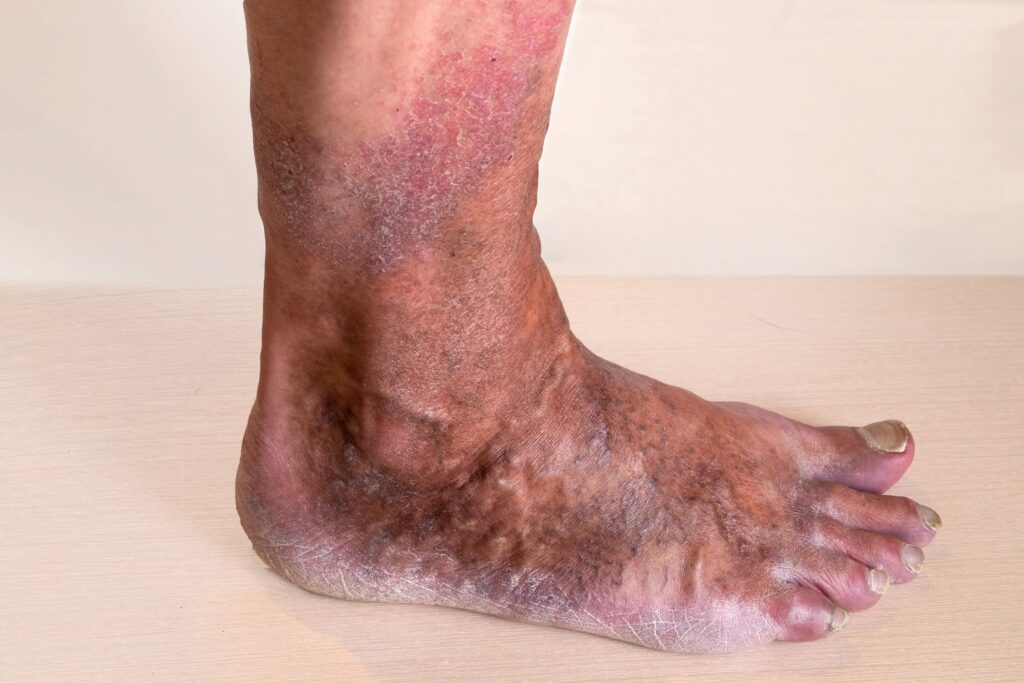
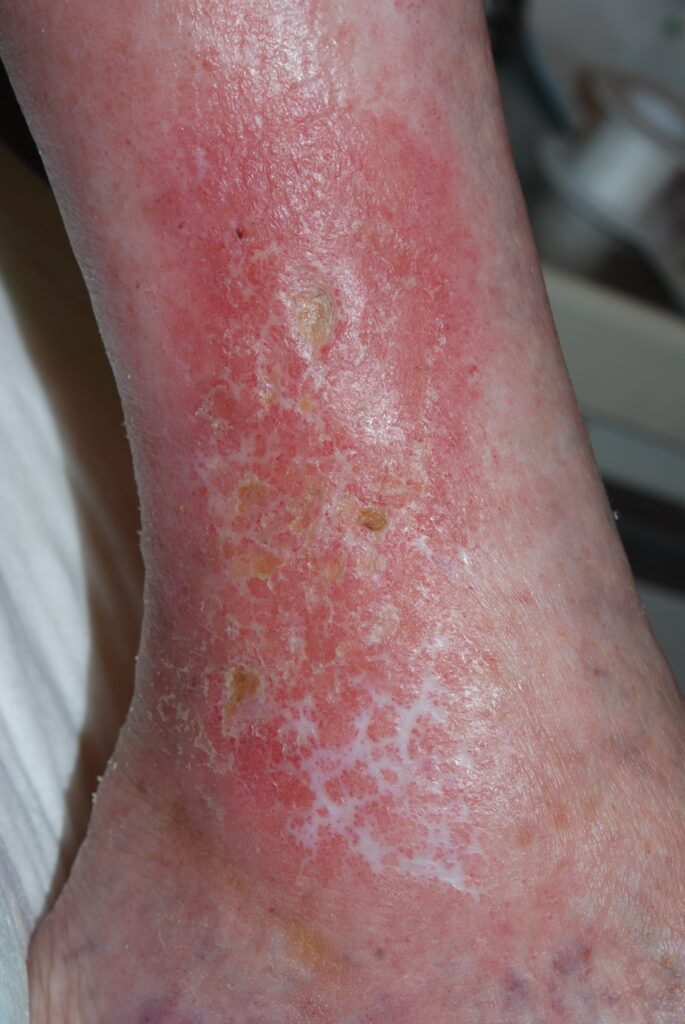

What is the treatment for venous stasis?
The treatment for venous stasis depends on the severity of the venous insufficiency and the underlying cause. Some common treatments include:
Compression Therapy:
Wearing compression stockings or bandages can help improve blood flow and reduce swelling in the legs. To wear compression stockings can also help prevent the development of leg ulcers and improve the signs of chronic venous insufficiency. Compression stockings are elastic stockings that apply an external compression to push the blood forward towards the heart. It also helps to prevent the formation of a blood clot in the varicose veins. Ulcers heal faster with compression therapy.
Exercise Regularly and Weight Management:
Maintaining a healthy weight and staying physically active by regular exercise can improve blood flow in the legs and reduce the risk of developing venous dermatitis.
Elevation of the Legs:
Maintaining the legs elevated above the level of the heart can help reduce swelling and improve blood flow in the legs, in addition to avoid standing for long periods.
Medications:
Topical steroids or other anti-inflammatory creams may be used to reduce inflammation and itching associated with venous dermatitis. Other medications, such as diuretics, may be used to help reduce swelling.
Surgery:
In some cases, surgery may be necessary to repair damaged veins or valves or to remove blood clots. Vein stripping has been for a long time the main surgical option. Today, a minimally invasive procedure such as endovenous laser ablation or radiofrequency ablation can be used to treat chronic venous insufficiency as other treatments option through small incisions, and has replaced vein stripping.
Lifestyle Changes:
Quitting smoking and maintaining a healthy diet can help improve overall vascular health and reduce the risk of developing venous stasis. your healthcare provider can help you.
Does venous stasis go away?
Venous stasis is a chronic condition that cannot be cured but can be managed with appropriate treatment.
It is one of the complications of chronic venous insufficiency.
Treatment can help reduce the symptoms of venous stasis and prevent complications such as the development of leg ulcers or deep vein thrombosis, even in severe cases of chronic venous insufficiency.
However, if left untreated, venous stasis can worsen over time and lead to more serious complications such as post thrombotic syndrome following a deep vein thrombosis ( or blood clot) of the larger veins. Therefore, it’s important to seek medical attention with your healthcare provider if you have symptoms of the condition.
The goal of treatment is improving blood flow in the legs and reducing swelling, which can help relieve symptoms and prevent complications over long periods.
To Summarize
Venous stasis is a common condition that can lead to chronic venous disease, which is characterised by a range of symptoms and complications that develop over time.
The stages of chronic venous disease are closely related to venous dermatitis and can be treated with a combination of lifestyle changes, medications, and procedures.
It is important to seek medical attention if you are experiencing symptoms of chronic venous disease to prevent complications and improve your quality of life.

